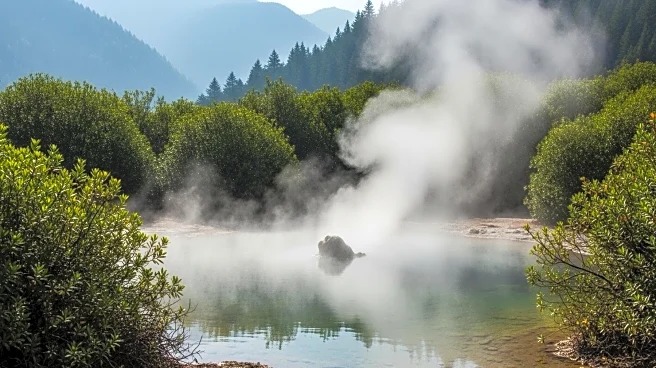What's Happening?
A recent study conducted by researchers at the Earth-Life Science Institute (ELSI) in Tokyo, Japan, has explored the role of iron-rich hot springs in understanding early Earth's microbial ecosystems. Led by graduate student Fatima Li-Hau and supervised by Associate Professor Shawn McGlynn, the research focused on five hot springs in Japan that mimic the chemical conditions of Earth's ancient oceans. These springs, rich in ferrous iron and low in oxygen, provide a natural laboratory to study microbial metabolism during the Great Oxygenation Event (GOE) around 2.3 billion years ago. The study found that microaerophilic iron-oxidizing bacteria were dominant in these environments, using ferrous iron as an energy source. The presence of Cyanobacteria, known for oxygen production through photosynthesis, was also noted, albeit in smaller numbers. The research highlights the coexistence of diverse microbial communities that carried out essential biological processes such as carbon and nitrogen cycling.
Why It's Important?
This study is significant as it sheds light on the transitional ecosystems that existed before the rise of atmospheric oxygen, a pivotal moment in Earth's history. Understanding these early microbial communities provides insights into how life adapted to increasing oxygen levels, which were initially toxic to ancient organisms. The findings suggest that early microbes harnessed energy from iron oxidation and oxygen produced by phototrophs, offering a new perspective on the evolution of life on Earth. This research not only enhances our understanding of Earth's past but also has implications for the search for life on other planets with similar geochemical conditions. By studying modern analogues like these hot springs, scientists can better comprehend the metabolic potentials and community compositions relevant to early Earth's conditions.
What's Next?
The study opens avenues for further research into the complex interactions within early microbial ecosystems and their adaptation to changing environmental conditions. Future investigations may focus on the 'cryptic' sulfur cycle observed in the hot springs, where microbes recycle sulfur in ways not yet fully understood. Additionally, the research could inform astrobiological studies, aiding in the identification of biosignatures on other planets. The findings may also inspire interdisciplinary collaborations to explore the origins and co-evolution of life and Earth, as facilitated by institutions like ELSI.
Beyond the Headlines
The research underscores the importance of interdisciplinary approaches in understanding Earth's history and the potential for life beyond our planet. It highlights the role of international collaboration in advancing scientific knowledge, as exemplified by Japan's World Premier International Research Center Initiative. The study also emphasizes the need to preserve unique natural environments like hot springs, which serve as vital research sites for studying ancient life forms and their ecosystems.










